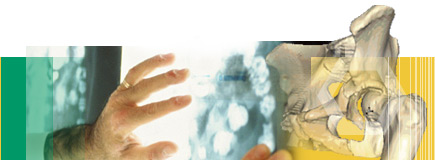|
Digital Data Distribution (as per RACS DDI Options)
Distribution of digital images by network or electronic media has considerable advantages. However, the infrastructure must be is in place to ensure that appropriate quality digital images can be viewed by the treating practitioner at all stages and in all locations where the viewing of images needs to occur for optimal patient care.
The currently available "Optimum" and "Acceptable" means of diagnostic image distribution are listed below:
|
Stage 2
Image Data Distribution |
Optimum |
Acceptable (qualified) |
|
1. WAN / LAN with at least
1 GBit speed PACS access (or functional equivalent) for real time loading and viewing.
2. Secure server online DICOM data with selectable data quality download for remote and fallback access
Note - server access is appropriate where the treating doctor is a regular user of a particular service
3. CD for patient image data transfer, separate from main long term storage
- only if accessible by end-user usable systems and workflow (i.e. PACS to PACS) |
1. WAN / LAN with less than 1 GBit speed for online access to diagnostic quality images linked with report -
- XDS-I
- Thin client PACS
- Only suitable if data delivery speed is acceptable due to pre-fetching, pre-loading or queuing.
2. SSD (solid state drive) – USB SSD or similar data card for patient carried records.
Note: Industry standard and production model not yet defined.
3. Laser printed transparent film - high quality, full size images.
**less suitable for cross-sectional imaging studies with numerous images
4. High quality paper copy (limited application |
These various options may be offered by a variety of vendors and suppliers.
Digital diagnostic imaging distribution:
To achieve a suitable transition to the digital delivery of image data and reduce the reliance on film, specific criteria are required:
1. Digital images of an appropriate quality should be captured and distributed at an appropriate quality, including scout images for cross-sectional studies
2. The means of distribution should not only be consistent with the technological capabilities of the diagnostic imaging service and the referring practitioner, but also should consider the needs of any clinician involved in the subsequent management of the particular disease process in question. This relates to factors including speed of image data loading, the ability to access multiple studies simultaneously and the availability of suitable image data loading and display technology, with avoidance of propriety formats and systems that may not be compatible with cross vendor platforms.
3. Network of sufficient capacity for the clinical workload (1 Gbps network capacity is common in hospitals and large clinics).
4. Image distribution must comply with DICOM standards and IHE profiles;
5. The means of delivery must enable access to images within an acceptable time frame and must be compatible with the workflow requirements of the treating doctor. Equally, referring doctors must consider how their workflow could reasonably be modified to make best use of newer means of delivery.
6. Clinicians must have access to, and training in the use of, a DICOM image viewer, and preferably one version of the viewer software, to enable them to gain familiarity with the user interface. Some specialties require additional software such as Orthopaedic templating and multi-planar reconstruction.
7. Images need to be accessible in other clinical locations, with particular emphasis on operating theatres, clinics, wards and clinical meetings.
Digital Data Distribution Options:
1. Network access – WebPACS or WebLink download
Network access may be significantly limited by transmission speed, particularly for large data sets. Although Network and Web access is seen as the principal means of image access in the long term, network speed and capacity, security issues and the multitude of individual data storage and repository systems are currently limiting applicability in many areas - as detailed above.
WebPACS: This provides access to the images held on the radiology service PACS and allows them to be accessed of a local or wide area network, or via the internet.
The user is granted log in and password access to the PACS of a specific imaging provider to view images using either a web browser (Thin Client) or a local viewing application provided by the radiology provider (Thick Client). There are no standards for WebPACs with each PACS vendor implementing their own version with a unique user interface and functionality.
WebLink – image download: Images can be downloaded in as lossy quality (JPEG) or lossless (DICOM) depending on the preference and needs of the treating practitioner. DICOM images can then be reviewed using a DICOM viewer, and lossy images can be viewed using a web browser. The link is often embedded in the electronic radiology report.
2. Portable media
The image data is copied to the portable media and transported (usually the patient or post) to the treating health practitioner. The standard for portable media is IHE Portable Data for Imaging (PDI). Only certain portable media types have been approved (CDs prior to May 2009).
Extensions to the Portable Data for Imaging (PDI) Integration Profile - DVD and USB SSD
Where used, non-network digital media should be:
1. Fast loading - Loads quickly (on an appropriate end-user platform);
2. Reliable, non-volatile and with robust data storage;
3. Displayed on a simple intuitive software interface.
4. Un-editable
5. Externally labelled for content
3. Hard Copy Distribution (film or paper)
Where distributed on hard copy (film or paper), the printed images should be:
1. High resolution (not < 300dpi) printing;
2. Printed on High quality print medium (paper or film);
3. All images provided and printed at full size (as capture size),
(unless otherwise agreed by the referring doctor, and annotated on the image);
4. Printer must be DICOM PRINT compliant and certified
5. For Cross-sectional imaging (e.g. CT / MRI):
a) Must include a complete set (showing the whole volume of interest) of cross-sectional images in at least one plane, reconstructed at an appropriate section thickness. Reconstructed views in additional planes, and/or with additional image display windows, should also be included, where clinically appropriate.
b) At least one representative scout images in at least one orthogonal plane, with clearly identifiable anatomical landmarks, that relates to the images on that sheet must be printed on the same sheet
c) Where scout images contain multiple lines to represent cross-sections in an orthogonal plane, the density of the lines should not obscure the underlying anatomical detail
d) Where scout images contain multiple lines with numeric labels that reference a slice number in an orthogonal plane, the density of the numeric labels lines must be such that the labels remain legible. The image number on an individual image that corresponds to a scout image line must be clearly stated and not obscured by other numerical information.
Information on the printed images (transparent sheet film or paper) should include:
1. Patient demographics, date and imaging provider details
2. Means of capture (CR/ DR)
3. Compression if used:
i. Compression ratio and whether lossy or lossless
ii. no compression – default image quality and so no denotation on film;
4. Magnification and scale:
- “SC” (as scanned), FC (from capture), Full size or ADJ (Adjusted) to sized reference marker.
- Magnification relative to “Full size” should not generally be used unless requested. Images should be printed at the size they were captured onto the incident (CR/DR) plate.
- Reference ruler to allow calculation of magnification optional.
“Fit to film” specifically not allowable
Magnification or size adjustment if used:
With digital imaging, there may be difficulty in identifying the relationship between the size of the displayed image and the actual size of the imaged part. Previously, analogue film could only display at the size the “x-ray shadow” created. There was always a magnification factor due to beam divergence and the distance of the imaged part from the x-ray plate. Traditionally, adjustments to templating and direct measurements could be estimated by competent clinicians aware of the predictable and obligate magnification inherently caused by the divergent x-ray beam during image capture.
The advent of digital imaging and discretionary magnification (or minimisation) means that the actual size of the image on the exported hardcopy image can be varied, and an allowance made for the inherent magnification.
Terms such as “True Size”, “Real size”, “Anatomical size” or similar are now used by some providers. It may be unclear if these terms indicate that the displayed image matches the size that was actually captured onto the imaging plate, or if the capture image size has been adjusted using a reference marker. These terms can be confusing and ambiguous and thus should only be used if clearly and unambiguously defined.
The clinician needs to know whether the image size is as captured and displayed, as would be the case with analogue film, or if there has been some adjustment, typically based on the co-registration of a marker of a known size.
Clear and consistent designations might include:
“FC100” – (From capture), “SC100% (As scanned), “Full size”- indicates images are displayed at the actual size they were recorded onto the incident capture device or plate or,
“ADJ100” – displayed image size adjusted, based on a known reference marker size.
The hard copy should therefore contain information regarding the magnification or otherwise of the image in a prominent position on the printed image in an unambiguous format, and thus terms like "Anatomical Size" and "True Size" should be avoided.
|

